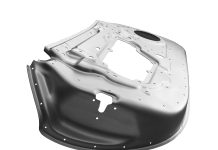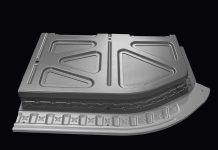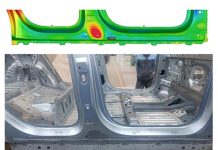Comparing New Projects to Historical Tool Cost and Scratching Your Head – Avoid These Pitfalls of Cost Estimations and Embrace the Future
In this blog post AutoForm Product Manager, Horst Vogt, examines a survey revealing how most OEMs and tool makers create their bids and cost projections for tool manufacturing. A variety of methods are revealed while a shocking 43% of die shops never get data to actual cost after production! Horst overviews the methods at work and the flaws of such approaches.

Recently one of our AutoForm consultants performed a live tool cost estimate using our software to demonstrate our cost estimations for two similar parts planned for production. The cost estimate of €600,000.00 for the first part was accurate and the prospective customer was impressed by the speed of the result. But, during a repeat of the demo for the “sibling” component, the cost projection arrived to roughly 900k€ even though the part was nearly the same.
The parts were very similar in size and design complexity and followed a similar stamping process. Naturally, it fits that the resource requirements should be the same. But when presented with these results, the prospect frowned and said that this second component cost 1.2 million euros. Their explanation: the second component was for the luxury line, the first was for the economy model.
That’s two versions of the same part for two different vehicle lines, with a total cost of 1.8 million euros. Would the two stamping processes really require so great a difference in tool manufacturing resources, or is the difference a post justification for the luxury model? Were the said numbers their quoted price, as according to their own costing expert, or actual costs? Did this organization compare their price expectations to their true costs? Were costs reported against their expectations?
Looking Under the Hood at Costing Models
If you had to review tool cost estimates from several tool shops (or even from two different individuals in the same quoting department), not only would you find differing cost estimates for the same parts, but, in looking deeper, you’ll also find completely inclusion of different details within each quote. Initial tool cost estimates rely greatly on the experience of the individual performing the estimate. How can part suppliers bid accurately this way?
Furthermore, there seems to be a near infinite number of ways the same part could be produced and the tools built, which naturally results in a wide range of costs, differing expectations for attainable quality, and even risk that the part can never be delivered as quoted.
During this study of 300+ tool shops in Germany, over 85% of the tool shops examined relied on expert opinion and a “similarity” cost estimation method; meaning that if “a part looks similar to part costed a million for its tools earlier, this new part must likewise cost a million.” From that initial estimated cost, they often attempt to break out the categories of costs based on historical percentages; from the top down.

Fewer than half of the toolmakers (45%) use analytical methods, while just over half (60%) employ cost functions. Cost functions assume that for every part feature one can predict a cost per size or length of feature, from labor costs down to material requirements. The statistics indicate that in every organization there is overlap in the application of techniques. A shop might start with a similarity method that an expert might re-interpret by applying some cost functions, then back-fill with information from analytical methods – at times adjusting the estimate to fit previous expectations/obligations. What does it all lead to? Unfortunately, in the study, the majority of tool makers saw that 25% of offers result in cost overruns, blowing the projected budget.
What’s the Disconnect All About?
One of the potential breakdowns in improving cost-estimating performance is the representation and categorization of costs when shifting from those early historical similarity methods (acknowledged to be used by 95% of toolmakers), to cost functions (used by 60% of toolmakers), to analytical methods (employed by only 45% of those companies participating in the study), followed by an attempt to reconcile the estimates to the actual costs accrued.
Estimates made by using similarity methods and most cost functions look back at historical expense proportions and assign those proportions to future parts. However, in the event that such “top down” estimates are reviewed after the fact, it is unlikely that anyone can specifically recognize what aspect of a particular part shape, in a proposed process and production environment, caused the price to match or miss the estimated costs. Interestingly, the die shops polled acknowledged that very few shops (43% of those surveyed) have access to data on actual costs!

One outcome of the study was a description of an ideal process to improve estimating: a system where tool cost estimates align with labor and expense tracking. Predicted resource requirements are used to plan engineering, machining, construction, and tryout—then, as the tool is built, these requirements are objectively compared to actual utilization of resources. This ideal method should deliver a reasonable estimate for resources required to deliver the die with the speed at which the similarity-methods and subjective expertise can generate a cost estimate today.
Only when all of the estimated resource requirements can be objectively compared to the actual resources used, can one actually improve quoting accuracy. It is not possible to reconcile an estimate based on a historical similarity method to a detailed cost estimate that allocates required man-hours, machine use, and proposed bills-of-material. Improving one’s own accuracy requires the ability to compare the educated guesses used early in the bidding process to the actual requirements using a similar categorization of costs and resources.
AutoForm has already incorporated such labor and expense tracking in reality within our own software, known as “AutoForm Planning and Bidding Solution.” It lets cost planners generate rapid quotes that are linked to both part geometry and production environment. Whether using a method based on initial rough process assumptions or detailed production intent process plans, the results are still reported in terms of specific categories of labor, machine, and materials costs, directly to our software using full integration via an ERP system. This process within our tool lets our users know that they are comparing “apples to apples.”
You can read more about the accuracy of our own solution here.













